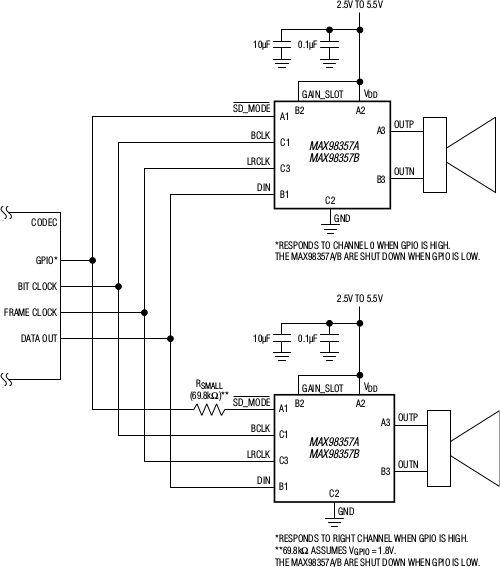- Posts: 1
Do you think this kind of SMD soldering is OK?
- Qiaonm
-
Topic Author
- Offline
Less
More
26 Jan 2018 10:13 #67184
by Qiaonm
Do you think this kind of SMD soldering is OK? was created by Qiaonm
On my PCB (connected to a Raspberry Pi, an Arduino, a C.H.I.P. or anything), I want to provide audio output for:
Instead of using
board ==(I2S)==> DAC => amp => speaker or headphones
I was thinking about :
board ==(I2S)==> amplifier such as MAX98357A => speaker or headphones
Problem : this MAX98357A( http://www.kynix.com/Parts/48494/MAX98357AETE%2B.html ) seems to be mono only. The datasheet suggests using two of them to make a stereo output, but I find it not very elegant solution.
Are there "all-in-one" (DAC+amp) solutions to provide stereo output? (I'm not looking for shopping advice, I just want to know if, as a general question, this exists or not).
Would using two such mono chips be considered as a normal practice?
The datasheet carries this example:
Moreover, this MAX chip looks hard to solder manually (SMD). Do you think this kind of SMD soldering is achievable manually?
- a small speaker
or, when a 3.5 mm minijack is inserted, to stereo headphones (that would disconnect the speaker)
Instead of using
board ==(I2S)==> DAC => amp => speaker or headphones
I was thinking about :
board ==(I2S)==> amplifier such as MAX98357A => speaker or headphones
Problem : this MAX98357A( http://www.kynix.com/Parts/48494/MAX98357AETE%2B.html ) seems to be mono only. The datasheet suggests using two of them to make a stereo output, but I find it not very elegant solution.
Are there "all-in-one" (DAC+amp) solutions to provide stereo output? (I'm not looking for shopping advice, I just want to know if, as a general question, this exists or not).
Would using two such mono chips be considered as a normal practice?
The datasheet carries this example:
Moreover, this MAX chip looks hard to solder manually (SMD). Do you think this kind of SMD soldering is achievable manually?
Please Log in or Create an account to join the conversation.
- webbbn
-
- Offline
Less
More
- Posts: 13
26 Jan 2018 16:19 #67196
by webbbn
Replied by webbbn on topic Do you think this kind of SMD soldering is OK?
Why not just use an SBC that has audio out built in, or just use a USB audio device?
ATM I like this board, which has audio out if you buy the shield: www.friendlyarm.com/index.php?route=prod...th=69&product_id=197
ATM I like this board, which has audio out if you buy the shield: www.friendlyarm.com/index.php?route=prod...th=69&product_id=197
Please Log in or Create an account to join the conversation.
- Brett_N
-
- Offline
Less
More
- Posts: 53
26 Jan 2018 19:41 #67201
by Brett_N
Replied by Brett_N on topic Do you think this kind of SMD soldering is OK?
You need a DAC or a CODEC. You can use one with an integrted audio amp like this guy.
You probably want the TLV320DAC23 since it's in a leaded pacakage - easier to hand solder than QFN.
www.ti.com/product/tlv320dac23/description
High-Performance Stereo DAC
100-dB SNR multibit sigma-delta ADC (A-weighted at 48 kHz)
1.42 V – 3.6 V digital supply: compatible with TI C54x DSP core voltages
2.7 V – 3.6 V analog supply: compatible TI C54x DSP buffer voltages
8-kHz – 96-kHz sampling-frequency support
Software control via TI McBSP-compatible multiprotocol serial port
2-wire-compatible and SPI-compatible serial port protocols
Glueless interface to TI McBSPs
Audio data input/output via TI McBSP compatible programmable audio interface
I2S-compatible interface
Standard I2S, MSB, or LSB justified data transfers
16/20/24/32-bit word lengths
Audio master/slave timing capability optimized for TI DSPs (250/272 fs)
Industry-standard master/slave support also provided (256/384 fs)
Glueless interface to TI McBSPs
Stereo line inputs
Stereo line outputs
Analog stereo mixer for DAC and analog bypass path
Analog volume control with mute
Highly efficient linear headphone amplifier
30 mW into 32 from a 3.3-V analog supply voltage
Flexible power management under total software control
18-mW power consumption during playback mode
Standby power consumption < 150 µW
Power-down power consumption < 15 µW
Industry’s smallest package: 32-Pin TI proprietary MicroStar Junior
25 mm2 total board area
28-Pin TSSOP available (62 mm2 total board area)
28-Pin QFN available (25mm2 total board area)
Ideally suitable for portable solid-state audio players and recorders
You probably want the TLV320DAC23 since it's in a leaded pacakage - easier to hand solder than QFN.
www.ti.com/product/tlv320dac23/description
High-Performance Stereo DAC
100-dB SNR multibit sigma-delta ADC (A-weighted at 48 kHz)
1.42 V – 3.6 V digital supply: compatible with TI C54x DSP core voltages
2.7 V – 3.6 V analog supply: compatible TI C54x DSP buffer voltages
8-kHz – 96-kHz sampling-frequency support
Software control via TI McBSP-compatible multiprotocol serial port
2-wire-compatible and SPI-compatible serial port protocols
Glueless interface to TI McBSPs
Audio data input/output via TI McBSP compatible programmable audio interface
I2S-compatible interface
Standard I2S, MSB, or LSB justified data transfers
16/20/24/32-bit word lengths
Audio master/slave timing capability optimized for TI DSPs (250/272 fs)
Industry-standard master/slave support also provided (256/384 fs)
Glueless interface to TI McBSPs
Stereo line inputs
Stereo line outputs
Analog stereo mixer for DAC and analog bypass path
Analog volume control with mute
Highly efficient linear headphone amplifier
30 mW into 32 from a 3.3-V analog supply voltage
Flexible power management under total software control
18-mW power consumption during playback mode
Standby power consumption < 150 µW
Power-down power consumption < 15 µW
Industry’s smallest package: 32-Pin TI proprietary MicroStar Junior
25 mm2 total board area
28-Pin TSSOP available (62 mm2 total board area)
28-Pin QFN available (25mm2 total board area)
Ideally suitable for portable solid-state audio players and recorders
Please Log in or Create an account to join the conversation.
Time to create page: 0.052 seconds
-
Home

-
Forum

-
General

-
General Discussions

- Do you think this kind of SMD soldering is OK?


